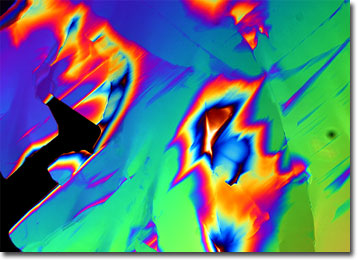Polarized Light Microscopy Digital Image Gallery
Grape (Synthetic)
Grapes are a sweet fruit that grow on vines belonging to the genus Vitis of the family Vitaceae. Cultivation of grapes has been ongoing since almost the beginning of civilization, but in more recent years, synthetic grape flavorings and fragrances have become a popular alternative to the real thing.

The earliest concentrated flavorings produced came from natural products, but around the beginning of the twentieth century, synthetic flavors began to emerge from laboratories. One of the first of these synthetics was a grape flavor produced from a chemical compound known as methyl anthranilate. The light yellow to brown liquid does not look similar to the fruit or its juice, but has a strong grape-like smell when diluted. Though widely used as a flavoring agent in foods and beverages and as a fragrance in perfumes, the synthetic substance is also known as an oxidation inhibitor, a sunscreening agent, and an intermediate for a broad range of chemicals, dyes, and pharmaceuticals. Interestingly, years after the discovery of its unusual odor, when improved equipment and laboratory techniques had been developed, scientists discovered that methyl anthranilate is actually one of the chemicals present in real grapes.
The role of smell in influencing the perceived taste of foods is well documented, but less well known is the similar importance of appearance. Yet, food and beverage producers habitually dye their products in an attempt to create more desirable food items. Recent research supports the wisdom of this practice since findings suggest that people closely identify the flavor of a drink with its color, meaning that purple-colored grape drinks are perceived to exhibit more grapiness than those that are dyed a different color. Indeed, in one experiment, synthetic fruit-flavored drinks that were dyed a different color than the one typically associated with the fruit they attempted to imitate were identified as the proper flavor by test subjects less than 25 percent of the time.
